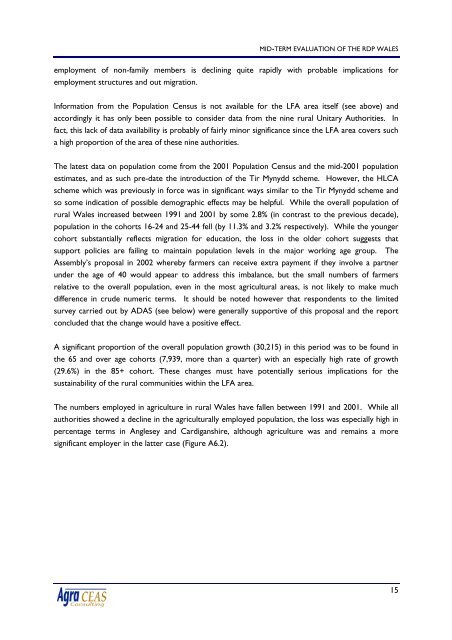A6 LFA annex.pdf - Agra CEAS Consulting
A6 LFA annex.pdf - Agra CEAS Consulting
A6 LFA annex.pdf - Agra CEAS Consulting
Create successful ePaper yourself
Turn your PDF publications into a flip-book with our unique Google optimized e-Paper software.
MID-TERM EVALUATION OF THE RDP WALESemployment of non-family members is declining quite rapidly with probable implications foremployment structures and out migration.Information from the Population Census is not available for the <strong>LFA</strong> area itself (see above) andaccordingly it has only been possible to consider data from the nine rural Unitary Authorities. Infact, this lack of data availability is probably of fairly minor significance since the <strong>LFA</strong> area covers sucha high proportion of the area of these nine authorities.The latest data on population come from the 2001 Population Census and the mid-2001 populationestimates, and as such pre-date the introduction of the Tir Mynydd scheme. However, the HLCAscheme which was previously in force was in significant ways similar to the Tir Mynydd scheme andso some indication of possible demographic effects may be helpful. While the overall population ofrural Wales increased between 1991 and 2001 by some 2.8% (in contrast to the previous decade),population in the cohorts 16-24 and 25-44 fell (by 11.3% and 3.2% respectively). While the youngercohort substantially reflects migration for education, the loss in the older cohort suggests thatsupport policies are failing to maintain population levels in the major working age group. TheAssembly’s proposal in 2002 whereby farmers can receive extra payment if they involve a partnerunder the age of 40 would appear to address this imbalance, but the small numbers of farmersrelative to the overall population, even in the most agricultural areas, is not likely to make muchdifference in crude numeric terms. It should be noted however that respondents to the limitedsurvey carried out by ADAS (see below) were generally supportive of this proposal and the reportconcluded that the change would have a positive effect.A significant proportion of the overall population growth (30,215) in this period was to be found inthe 65 and over age cohorts (7,939, more than a quarter) with an especially high rate of growth(29.6%) in the 85+ cohort. These changes must have potentially serious implications for thesustainability of the rural communities within the <strong>LFA</strong> area.The numbers employed in agriculture in rural Wales have fallen between 1991 and 2001. While allauthorities showed a decline in the agriculturally employed population, the loss was especially high inpercentage terms in Anglesey and Cardiganshire, although agriculture was and remains a moresignificant employer in the latter case (Figure <strong>A6</strong>.2).15













